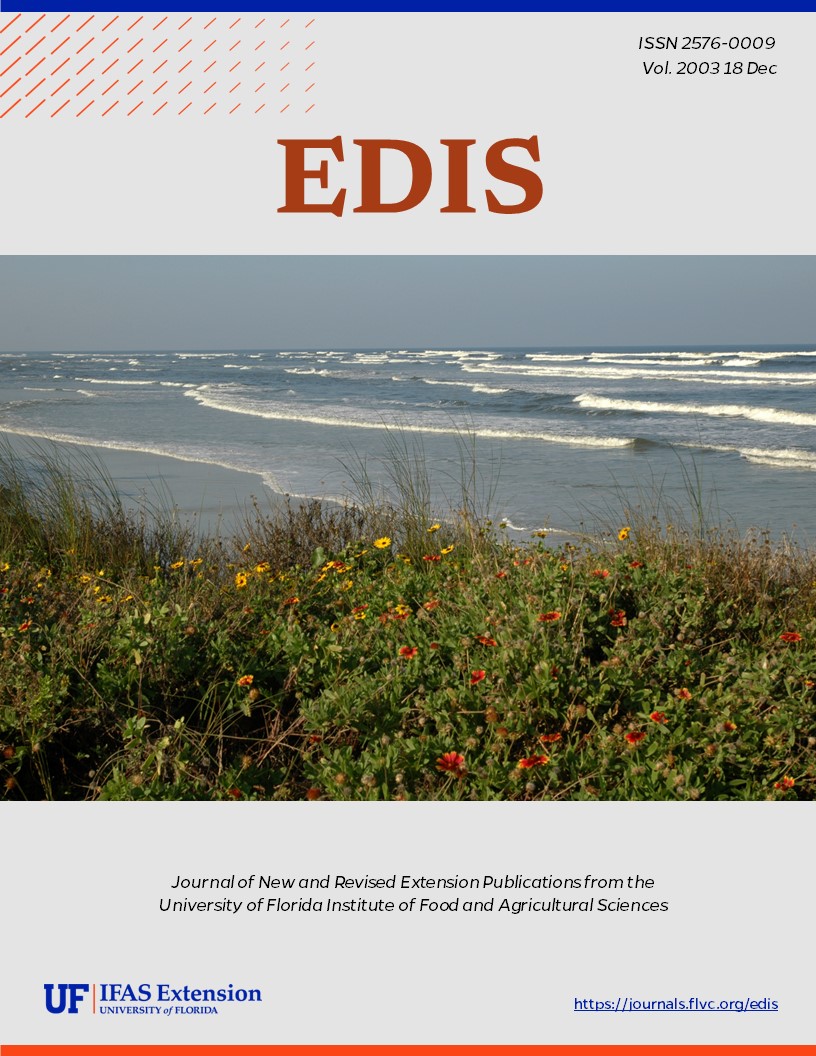Abstract
The family Tabanidae, commonly known as horse flies, and deer flies, contains pests of cattle, horses and humans. In Florida there are 35 species of Tabanidae that are classed as economically important. Horse flies are in the genus Tabanus, deer flies are in the genus Chrysops. The yellow fly, Diachlorus ferrugatus (Fabricius), is known as a fierce biter in Florida. Like mosquitoes, it is the female fly that is responsible for inflicting a bite. The males are mainly pollen and nectar feeders. Tabanids are most likely encountered in hot summer and early fall weather. They are active during daylight hours. This document is EENY-028, one of a series of Featured Creatures from the Entomology and Nematology Department, Florida Cooperative Extension Service, Institute of Food and Agricultural Sciences, University of Florida. Published: April, 1998. Revised: November 2003.
References
Anderson, J.F. 1973. Biting behavior of saltmarsh deer flies (Diptera: Tabanidae). Annals of the Entomological Society of America 66: 21-23. https://doi.org/10.1093/aesa/66.1.21
Burnet, A.M. and K.L. Hays. 1974. Some influences of meteorological factors on flight activity of female horse flies (Diptera: Tabanidae). Environmental Entomology 3: 515-521. https://doi.org/10.1093/ee/3.3.515
Borror, D.J., C.A. Triplehorn and N.F. Johnson. 1992. An Introduction to the Study of Insects. Sanders College Publishing, Ft. Worth. 512 pp.
Catts, E.P. and W. Olkowski. 1972. Biology of Tabanide (Diptera): mating and feeding behavior of Chrysops fulginosus. Environmental Entomology 1: 448-453. https://doi.org/10.1093/ee/1.4.448
Curran, C.H. 1934. The families and genera of North American Diptera. American Museum of Natural History, New York, P. 148-149. https://doi.org/10.5962/bhl.title.6825
Essig, E.O. 1958. Insects and Mites of Western North America. The Macmillan Co., New York. 1050 pp.
Fairchild, G.B. and H.V. Weems Jr. 1973. Doachlorus ferrugatus (Fabricius), a fierce biting fly (Diptera: Tabanidae). Florida Department of Agriculture and Consumer Services, Division of Plant Industry Circular 139.
Foster, C.A., G.D. Renuad, and K.L. Hays. 1973. Some effects of the environment on oviposition by Chrysops (Diptera: Tabanidae). Environmental Entomology 2: 1048-1050. https://doi.org/10.1093/ee/2.6.1048
French, F.E. and D.L. Kline. 1989. 1-octen-3-ol, an effective trap attractant for Tabanidae (Diptera). Journal of Medical Entomology 26: 459-461. https://doi.org/10.1093/jmedent/26.5.459
French, F.E. and D.L. Hagan. 1995. Two-tier box trap catches Chrysops atlanticus and C. fuliginosus (Diptera: Tabanidae) near a Georgia salt marsh. Journal of Medical Entomology 32: 197-200. https://doi.org/10.1093/jmedent/32.2.197
Hansens, E.J. and J.W. Robinson. 1973. Emergence and movement of the saltmarsh deer flies Chrysops fluginosus and Chrysops atlanticus. Annals of the Entomological Society of America 66:1215-1218. https://doi.org/10.1093/aesa/66.6.1215
Harwood, R.F. and M.T. James. 1979. Entomology in human and animal health. Macmillian Publishing Co., New York. 548 pp.
Herms, W.B. 1961. Medical Entomology. The Macmillian Co., New York. 582 pp.
Jones, C. M. and D.W. Anthony. 1964. The Tabanidae (Diptera) of Florida. U.S.D.A. Bulletin 1295: 1-85.
Koehler, P.G., D.E.Short and T.R. Fasulo. (1998). Pests In and Around the Home. UF/IFAS, CD-ROM.
Logothetis, C. and H.H. Schwardt. 1948. Biological studies on the horse flies of New York. Journal of Economic Entomology 41:335-336. https://doi.org/10.1093/jee/41.2.335
Mckeever, S and F.E. French. 1997. Fascinating, beautiful, blood feeders. American Enttomologist 43: 217-225. https://doi.org/10.1093/ae/43.4.217
Mizell, R.F. (December 1998). The trolling deer fly trap. UF/IFAS Pest Alert. http://extlab7.entnem.ufl.edu/PestAlert/deerfly.htm (December 1998).
Pechuman, L.L. 1973. Horse flies and deer flies of Virginia (Diptera: Tabanidae). Virginia Research Division Bulletin 81: 1-9.
Riley, W.A. and O.A. Johannsen. 1938. Medical Entomology. McGraw-Hill Book Co, Inc., New York. 483 pp.
Tashiro, H. and H.H. Schwart. 1949. Biology of the major species of horse flies of central New York. Journal of Economic Entomology 42: 269-272. https://doi.org/10.1093/jee/42.2.269
Wall, R. and D. Shearer. 1997. Veterinary Entomology. Chapman & Hall, New York. 439 pp. https://doi.org/10.1007/978-94-011-5852-7
Wilson, B.H. 1968. Reduction of Tabanid popoulations on cattle with sticky traps baited with dry ice. Journal of Economic Entomology 61: 827-829. https://doi.org/10.1093/jee/61.3.827
Unless otherwise specified, articles published in the EDIS journal after January 1, 2024 are licensed under a Creative Commons Attribution-NonCommercial-NoDerivs 4.0 International (CC BY-NC-ND 4.0) license.

